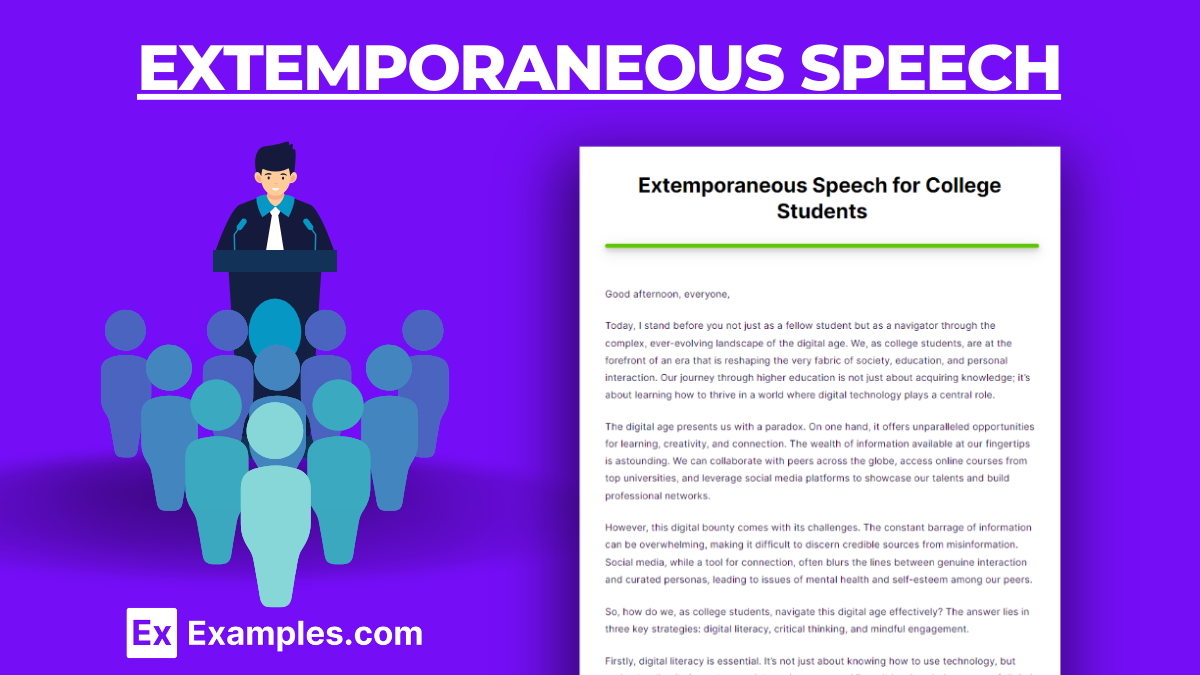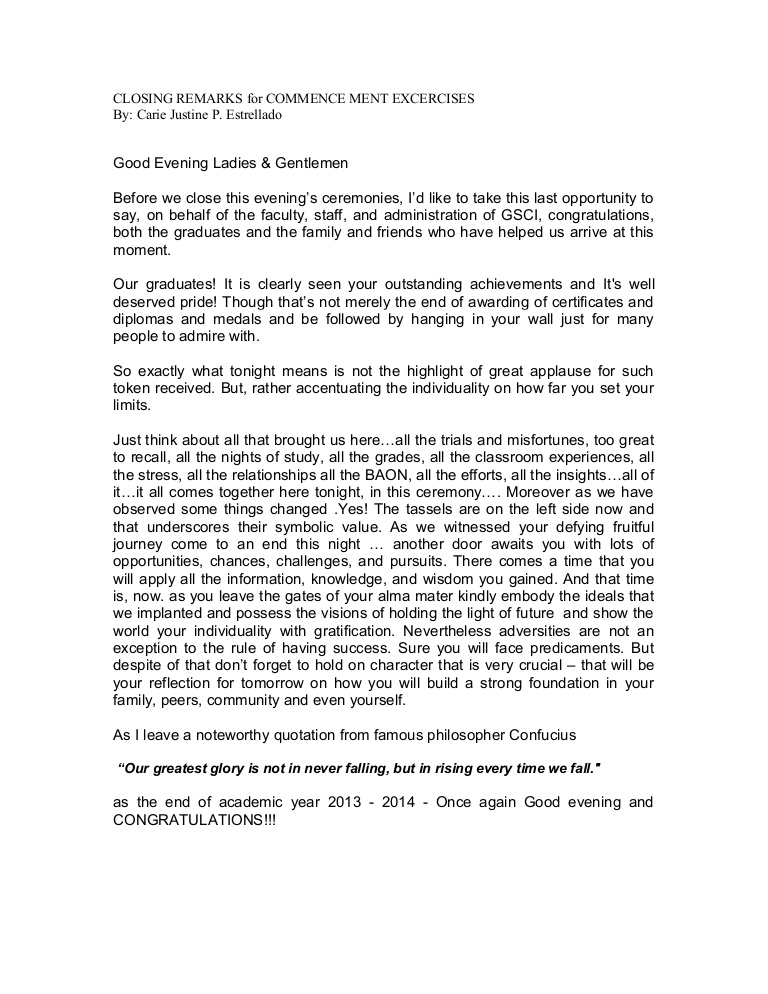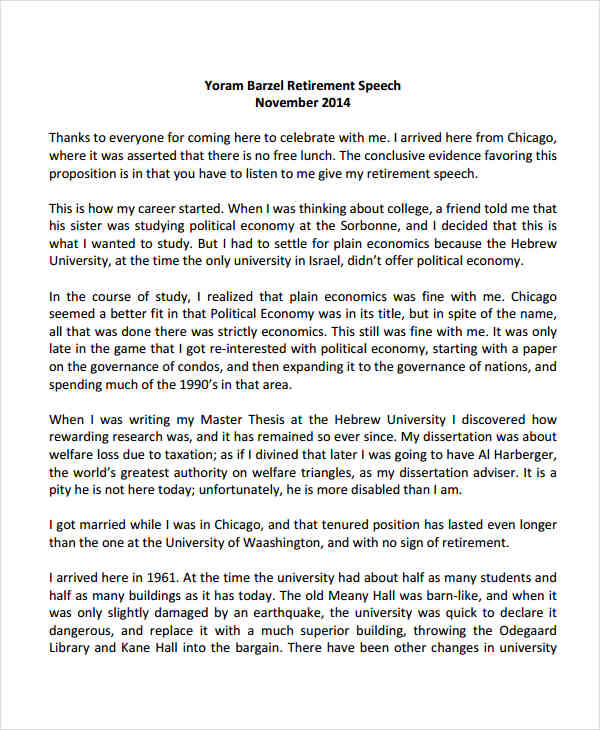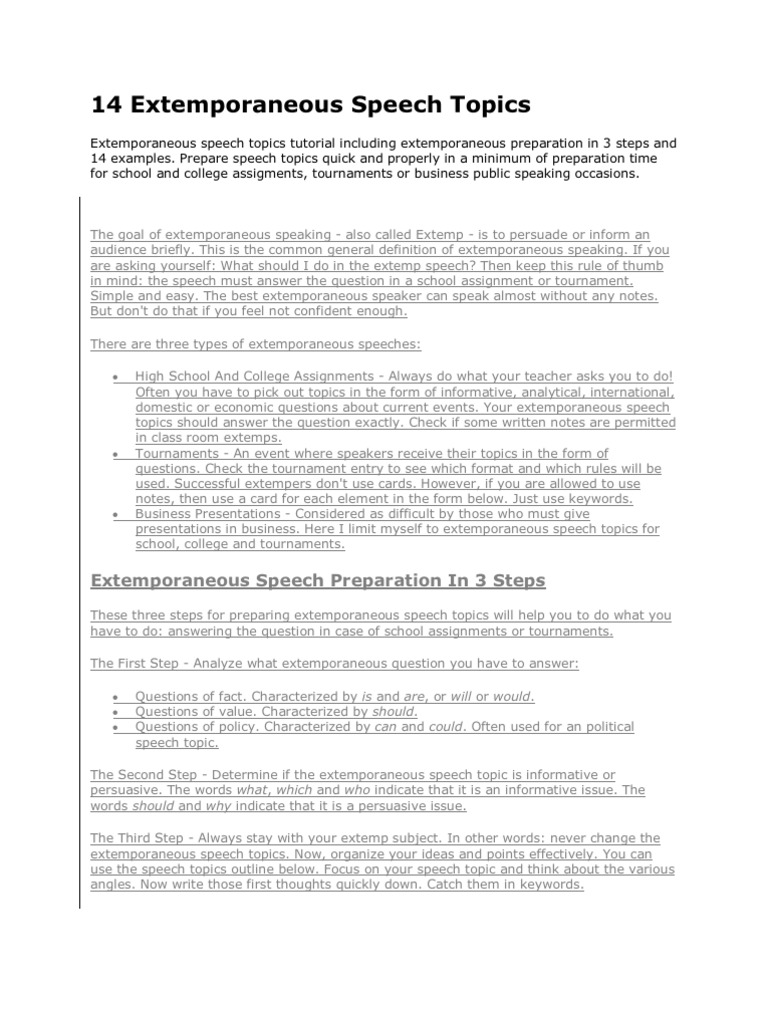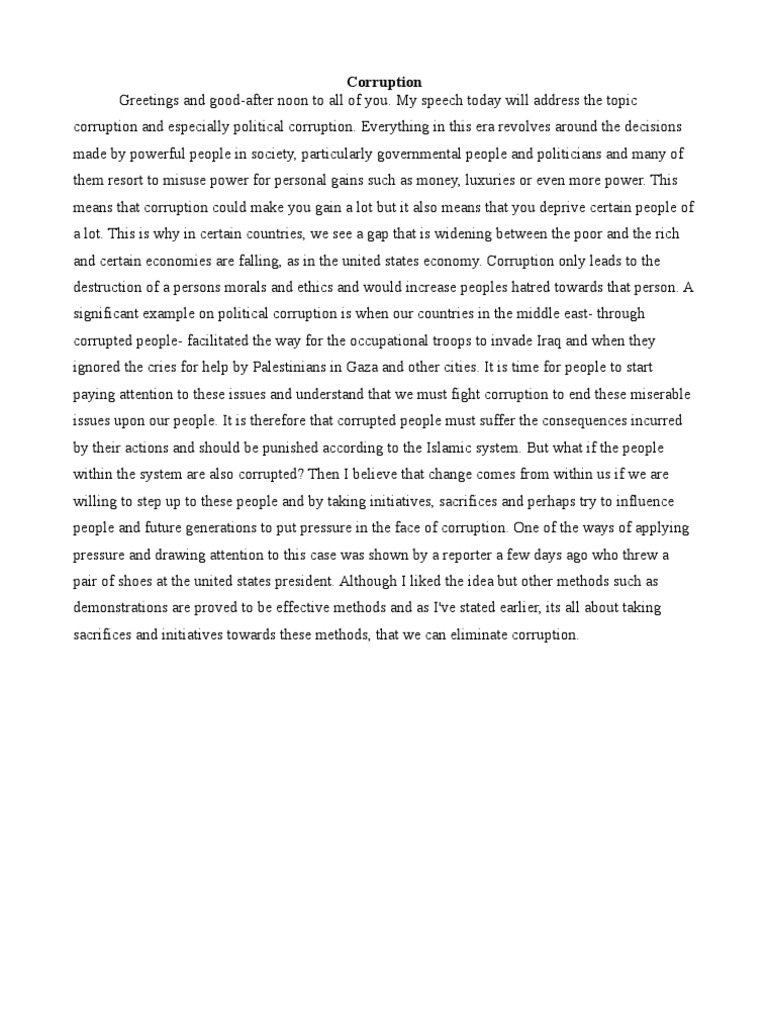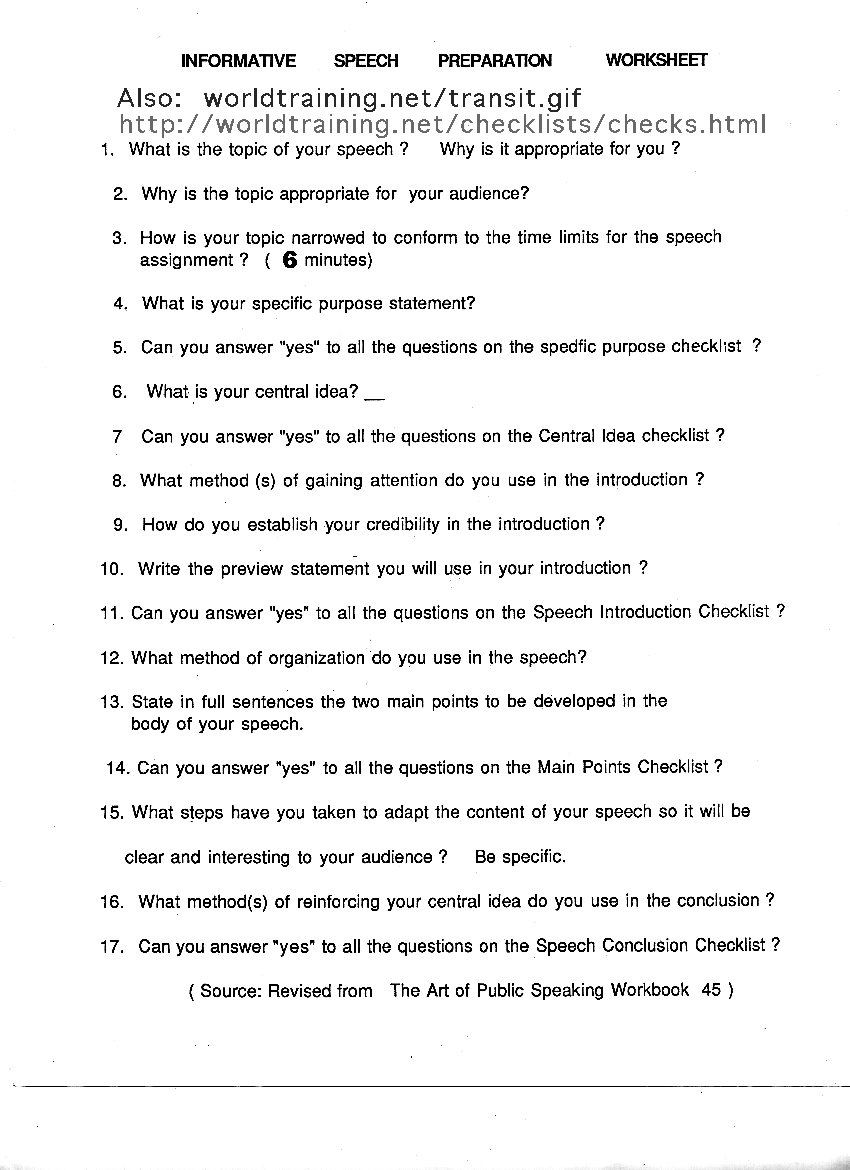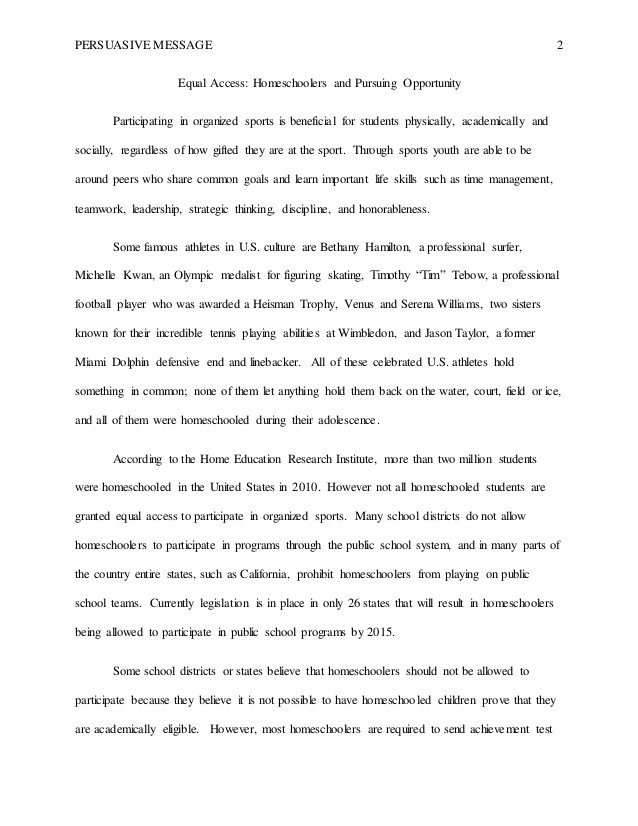20+ Extemporaneous Speech Examples to Download
Mastering an Extemporaneous Speech requires a balance of preparation and spontaneity. This guide, enriched with engaging speech examples, offers key insights into delivering compelling and impromptu speeches. Extemporaneous speaking, a valuable skill in both academic and professional settings, involves presenting a well-organized speech with limited preparation. Through our examples, learn how to effectively structure your thoughts, employ persuasive techniques, and deliver a speech that resonates with your audience, all while maintaining a natural and spontaneous delivery style.
What is Extemporaneous Speech?
Extemporaneous speech refers to a speaking format where the speaker delivers a presentation with little to no specific preparation time but has a general understanding of the topic. Unlike impromptu speeches, which are entirely unprepared, or manuscript speeches, which are read verbatim, extemporaneous speeches strike a balance by allowing speakers to prepare and organize their thoughts in advance, often with the help of notes or outlines. This method encourages speakers to speak in a more natural and spontaneous manner, yet with a coherent structure and well-developed content. Extemporaneous speaking is highly regarded in both educational settings and professional environments for its ability to combine preparation with the flexibility to adapt to audience reactions or questions, showcasing the speaker’s knowledge, eloquence, and ability to think on their feet.
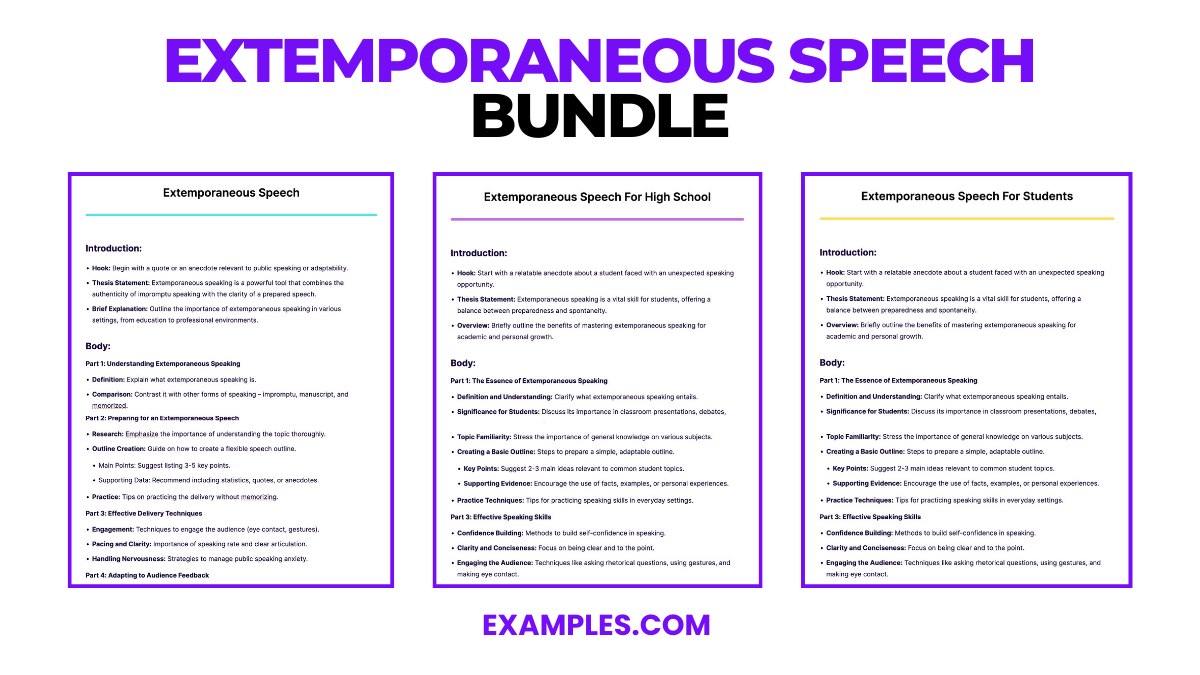
Download Extemporaneous Speech Bundle
The truth is, nobody claims to be perfect at public speaking. Everyone gets that unsettling feeling before a presentation where their hands grow cold and the butterflies run wild. Sometimes, it’s just a matter of how good you are at masking the anxiety. But public speaking can be especially challenging when giving an extemporaneous speech. Given the limited time available to prepare for the professional speech, you need to know how can make the best out of the situation for a successful delivery.
The Purposes of an Extemporaneous Speech
- Informing: To educate the audience about a specific topic, providing insights, data, and explanations to enhance understanding.
- Persuading: To convince the audience to adopt a particular viewpoint or take action on an issue, using logical arguments, emotional appeals, and credible evidence.
- Motivating: To inspire the audience to pursue a goal, change behavior, or overcome challenges, often involving stories of resilience or success.
- Entertaining: To provide enjoyment, capturing the audience’s interest through humor, storytelling, or thought-provoking content.
- Adapting: To adjust the message based on the audience’s reactions, feedback, or the specific context of the speech, ensuring relevance and engagement.
- Engaging: To foster a connection with the audience, encouraging interaction, questions, or further discussion about the topic.
- Reflecting: To share personal insights, experiences, or reflections that can resonate with the audience, making the speech more relatable and impactful.
How to Give an Extemporaneous Speech?
An extemporaneous speech involves a blend of preparation and the ability to adapt your message dynamically. Here’s how to effectively deliver an extemporaneous speech:
- Research and Understand Your Topic
- Plan Your Main Points
- Practice with Notes
- Know Your Audience
- Start Strong
- Use Natural Language
- Incorporate Pauses and Emphasis
- Maintain Eye Contact
- Adapt and Be Flexible
- Conclude Effectively
- Reflect and Improve
- Stay Confident and Positive
Extemporaneous Speech Format
Introduction
- Hook: Start with an engaging statement to capture the audience’s attention.
- Thesis Statement: Clearly state the main argument or purpose of your speech.
- Preview: Briefly outline the main points you will cover.
Body
- Point 1: Present your first main point, supported by evidence, examples, or anecdotes.
- Support: Provide data, quotes, or specific examples to substantiate your point.
- Point 2: Move to your second main point, again with supporting details.
- Support: Use additional evidence or examples to strengthen your argument.
- (Optional) Point 3: If time allows, present a third point with corresponding support.
Conclusion
Summary: Recap the main points you’ve discussed, reinforcing your thesis.
Closing Statement: End with a powerful statement, call to action, or a thought-provoking question to leave a lasting impression on your audience.
Extemporaneous Speech Samples
- Extemporaneous Speech for Students
- Extemporaneous Speech for High School
- Extemporaneous Speech for Middle School
- Extemporaneous Speech about Poverty
- Extemporaneous Speech for College Students
- Extemporaneous Speech for My Family
- Extemporaneous Speech for Global Environmental Issues
- Extemporaneous Speech for Technological Advancements and Society
- Extemporaneous Speech for Leadership in the 21st Century
- Extemporaneous Speech for The Impact of Social Media on Youth
- Extemporaneous Speech for Mental Health Awareness
- Extemporaneous Speech for Cultural Diversity and Inclusion
- Extemporaneous Speech for Economic Trends and Their Global Effects
- Extemporaneous Speech for Climate Change and Sustainable Living
Extemporaneous Speech Example

Extemporaneous Speech For Students

Extemporaneous Speech For High School
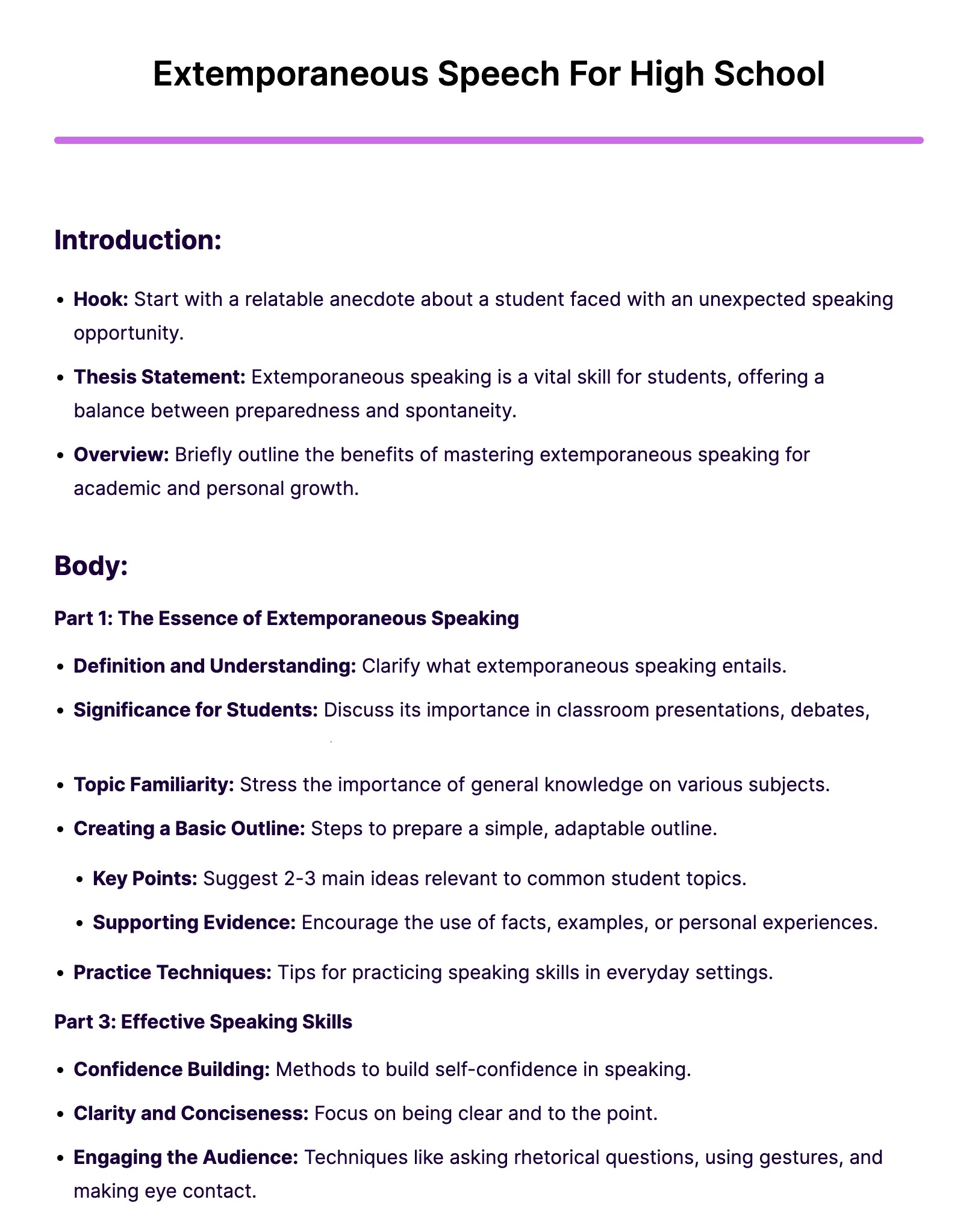
Extemporaneous College Graduation Speech Example
Extemporaneous Debate Speech Example
Extemporaneous Graduation Speech Example
Extemporaneous Speech for Retirement Example
Extemporaneous Speech Topic Example
Extemporaneous Speech on Corruption Example
Simple Extemporaneous Speech Example
Extemporaneous Wedding Speech Example
Extemporaneous Welcome Speech Example
Short Extemporaneous Speech Example
Extemporaneous vs Impromptu Speech
| Feature | Extemporaneous Speech | Impromptu Speech |
|---|---|---|
| Preparation | Short preparation time before speaking, with an organized structure in mind. | No preparation time; speaking on the spot without prior planning. |
| Notes | Use of notes or bullet points is common to guide the speech. | No notes are used; completely unscripted. |
| Delivery | Delivery is more polished and structured, but still allows for some spontaneity. | Delivery is entirely spontaneous, relying on the speaker’s immediate thoughts and reactions. |
| Flexibility | Flexible to some extent; allows for adapting to audience reactions while maintaining a planned structure. | Highly flexible; the speaker adapts instantly to the audience and setting. |
| Purpose | Often used in settings that require a well-thought-out argument or presentation, such as seminars or competitive speaking. | Common in casual or informal settings, or when a speaker is asked to give a sudden opinion or response. |
| Practice | Requires practice in organizing and structuring thoughts quickly, as well as familiarity with the topic. | Practices quick thinking and the ability to articulate thoughts coherently without preparation. |
| Audience Engagement | Structured to engage the audience with a clear flow of ideas, potentially more in-depth content. | Relies heavily on the speaker’s charisma, wit, and ability to connect with the audience on the fly. |
| Time Management | Time is managed according to the planned structure, with a clear beginning, middle, and end. | Time management is improvised, with the speaker having to gauge and adjust on the spot. |
The Basics of Extemporaneous Speaking
Imagine that you’re working hard on a new project that’s due in about three weeks when suddenly, a coworker comes in to inform you that the client is waiting at the conference room down the hall for an update on the latest model. You tell your coworker that you’d be there in five minutes tops, then reality dawns on you that 300 seconds may not be enough to prepare a clear and meaningful presentation. You may also see 8 steps in speech composition.
Can you deliver a concise and compelling message in such short notice? Or will you stammer through each word that leaves your lips?
If you identify yourself as someone belonging to the second category, you’re not alone. A lot of people, even the most respected executives of an organization, struggle with impromptu communication. This is a problem that many individuals consider as one of their major weaknesses that have hindered their performance at work. You may also like speech examples for students.
Luckily, extemporaneous speaking is actually a skill that may be developed and even mastered. Though many of the techniques used in formal presentations may not apply to extemporaneous speaking, they may be enhanced and incorporated into an individual’s presentation skills in more ways than one. You may also check out how do you write a speech?
Extemporaneous speaking, otherwise known as impromptu (from the word improvisation) or off-the-cuff speaking, is a speech event that involves limited preparation regarding a topic based on the speaker’s research and personal analysis. Although this may be one of the most difficult types of simple speech to deliver, it can also be a fun and rewarding experience that can help boost your confidence and career.
Extemporaneous Speaking: How to Perform under Pressure
An extemporaneous speech is only considered as such if it is created quickly without a script to follow. With just a few days’, hours’, or even minutes’ notice, the speaker must be smart enough to utilize the remaining time to prepare for his or her speech.
Some speakers possess this natural ability to create an improvised speech that can sound logical yet unforced, but it’s not because their minds are quick enough to process information, but because they’ve developed this clever method to organize their thoughts in such a way that is time-bound and sensible. You may also see launch speech examples.
1. Use a proper structure.
Think about it this way. When we work under a strict time pressure, our body immediately sets itself into maximum overdrive. Somehow, we manage to do multiple things at a time just so we could meet the proposed deadlines. When this happens, we fail to complete each item on the list as successfully as the other due to the lesser amount of attention given to these tasks. You may also like campaign speech examples.
Similarly, when delivering an extemporaneous speech, the mind divides itself in order to perform two essential activities.
One part of your brain would focus on determining the right message to convey, while the other part would concentrate on the desired structure of the speech. But the human brain can only do so much at a time, which means you’ll only be able to use half of your total brain power to perform each task, this can then lead to poor execution.
For this reason, it’s important to prepare a solid structure for your speech. A speech outline will make it easier for you to follow an imaginary structure without putting too much thought into it. Once you have developed a structure that works for you, all that’s left to do is to fit your content into it. This method can help you deliver articulate and concise extemporaneous speeches like a pro.
2. Formulate thoughts about the topic.
Having a great outline is one thing, but creating your content is a whole other factor that must be addressed for the outline to be put into good use. If you don’t know much about the topic, then the structure alone won’t be able to save you. You might be interested in appreciation speech examples & samples.
As a professional, you need to be aware of everything that goes on around you. This includes projects, deadlines, and milestones that concern you.
Coming unprepared to a meeting or interview can be extremely dangerous, especially if you haven’t been paying attention to your assigned workload. Keep in mind that not everyone is an expert at remembering content. And if you happen to be one of these people, then maybe an index card, a paper, or even the notes app on your mobile phone would come in handy.
Rather than complete sentences, make a list of important words or phrases that can help you remember key points about the topic. Quick glances at this copy allows you to maintain eye contact with your audience at all times. Though you might not use it during your presentation, it can help keep your mind at ease just in case. You may also see special occasion speech examples.
3. Create an outline.
Since you have already formulated an appropriate structure for your speech, it’s not time to fill your outline with useful content. This means putting the major points of your formal speech into actual sentences that are relevant to your cause.
Though memorizing an entire speech is highly discouraged, you still need to give yourself an idea on how the topic may be delivered. The ideas included in your outline will make it easier for you to emphasize important concepts that must be shared to the group. This way, you’d only have to worry about filling the spaces between each subpoint for a quick and coherent speech delivery. You may also like dedication speech examples.
4. Utilize extemporaneous style methods.
Extemporaneous speaking usually involves a conversational tone. This requires you to speak directly to your audience, with the frequent scanning, eye contact, and smiling (if applicable) in order to keep listeners engaged. Though lengthy pauses are more common in extemporaneous speeches compared to other forms of speaking, this should not be something to worry about. You may also check out after dinner speech examples.
More often than not, a strategic pause can add a dramatic effect to your speech. This allows an audience to ponder on a thought that had just been shared, which can also make your points more profound. As long as you can keep it short, a well-placed pause offers you the opportunity to think about your next thought for a split second or so. You might be interested in how do you write a speech?
5. Practice! Practice! PRACTICE!
One of the challenges involved in extemporaneous speaking is your inability to practice at whatever time you have. It can be difficult to enhance your skills if there isn’t anyone there to judge the outcome. If possible, you can have a friend or a coworker help you out during these practice sessions. This gives you the chance to practice in front of a potential audience member, and criticize your mistakes or lapses that might need some improvements. You may also see tribute speech examples.
What NOT to Do in Public Speaking
An extemporaneous speech, or any types of speech in that matter, can be a struggle to deliver without the proper guidance. To help you improve your skills in speech delivery, here are some tips on what you shouldn’t do in public speaking:
1. DON’T memorize!
Rather than memorizing your piece word for word, focus on familiarizing each line. This will make it easier for you to improvise whenever it gets difficult to recall a particular word or sentence from your speech. Keeping an index card in your pocket might also be useful just in case you desperately need it. You may also see narrative speech examples.
2. DON’T stress over detail.
Admittedly, you might not be the best at pronunciations. Grammar seems more like an acquaintance rather than a best friend as well. But stressing over every word and detail of your speech isn’t going to do you any favors. Instead, practice eloquently on a regular basis. This will soon become a habit that will help enhance your performance. You may also like leadership speech examples.
3. DON’T be intimidated by others.
Many people hate speaking in front of an audience in fear of being judged. But the only thing that’s really stopping you from taking the opportunity is the negative mind-set that you possess. You need to practice speaking in front of other people in order to overcome this fear. Although it may take time before you grow completely comfortable, this is a skill that must be developed for your own personal and professional sake. You may also check out after dinner speech examples.
4. DON’T speak too quickly.
If you let the nerves get the best of you, you’d end up speaking too quickly. This will make it difficult for listeners to understand what you’re trying to convey as you constantly stumble over your own words.
So the next time you stand in front of a microphone, remember to take a deep breath before you let your confidence take over. A few strategic pauses will also give you enough time to think thoroughly before you continue on with your speech. You might be interested in school speeches examples.
5. DON’T assume your audience knows everything.
Whether you’re delivering a motivational speech or a school welcome speech, remember to be yourself. People can’t predict every word that’s about to come out of your mouth, which is why they’re staring at you so intently. These people aren’t there to judge you rather, they’re there to listen to what you have to share with them. The best you can do is to let your personality in order to make the speech meaningful and memorable to your audience.
Now that we’re aware of how we can improve our skills in public speaking, it’s time that we erase the perception that extemporaneous speakers are born that way. Nobody was born to be an impromptu speaker, not even the CEO of a respected firm, nor the leader of the free world. You may also see dedication speech examples.
Extemporaneous speaking is a skill that one can only develop through constant practice and improvement. With the proper mind-set and attitude in place, you can deliver an impressive extemporaneous speech in no time!
FAQs
Rules for Extemporaneous Speaking
Extemporaneous speaking involves delivering a speech with little preparation, using notes or brief outlines rather than a full script. The key rules include understanding your topic deeply, practicing structured delivery, keeping within time limits, engaging with the audience through eye contact, and using clear and concise language. This format balances preparedness with spontaneity, allowing flexibility in addressing the audience’s reactions or questions.
Example of Extemporaneous Speech
An example of an extemporaneous speech might begin with an introduction to the topic, such as the importance of renewable energy, followed by structured points like current energy challenges, benefits of renewable sources, and ending with a call to action or solution. The speaker uses notes for reference but relies on their knowledge and speaking skills to engage the audience.
Example of an Extemporaneous Speech Situation
A common situation for extemporaneous speaking could be a debate competition where participants are given topics shortly before they speak. Another scenario is a business meeting where a team member is asked to present a project update without prior preparation. These situations require speakers to organize their thoughts quickly and convey their message effectively within a short timeframe.


